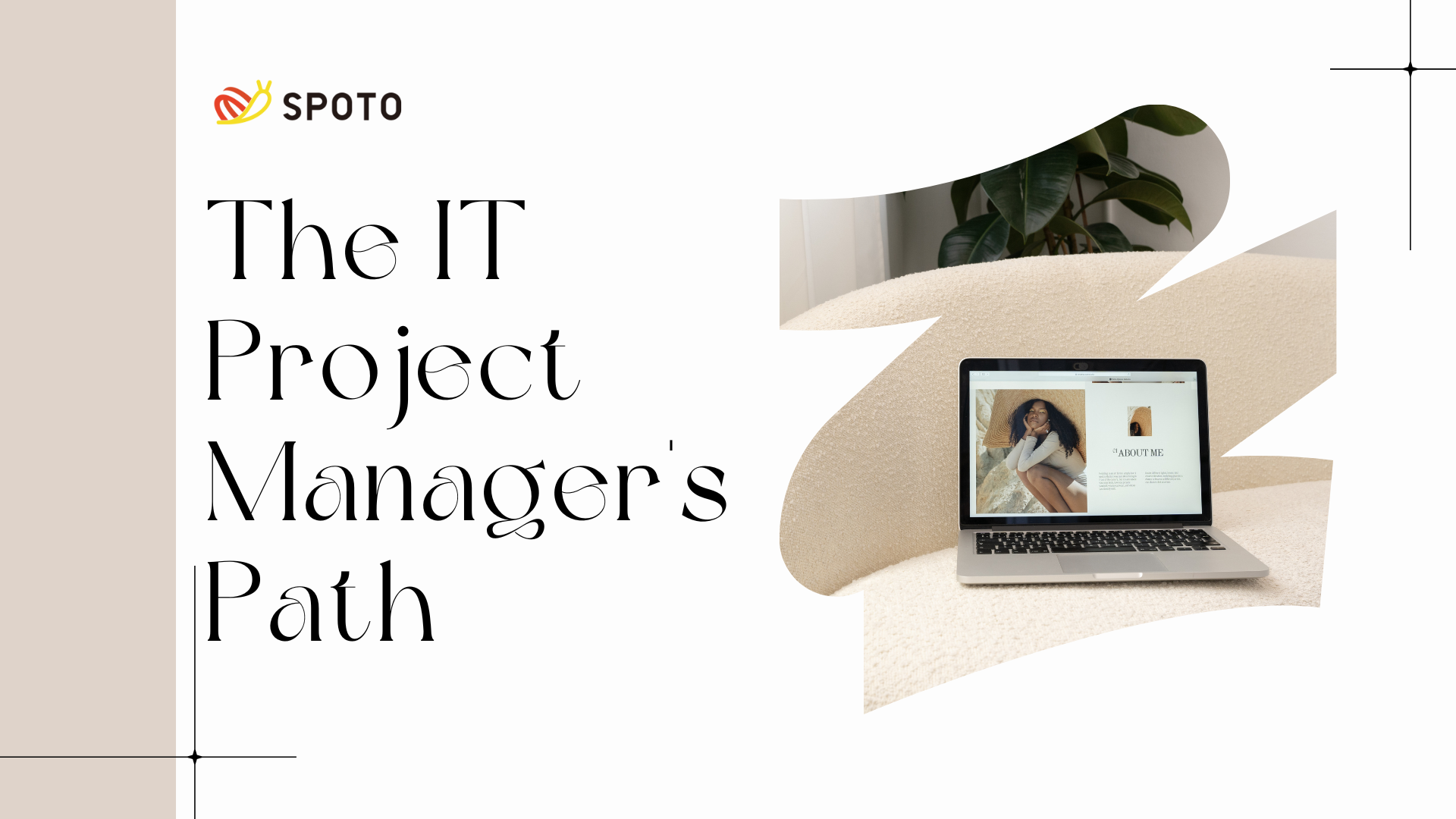TRUSTED BY THE SMARTEST TEAMS IN THE WORLD FOR CERTIFIED CANDIDATES
SPOTO Blogs
Useful learning materials to become certified IT personnel
-
- 1055
- Emma
- 2025-05-22 11:17
-
- 965
- Emma
- 2025-05-09 09:18
-
- 957
- circle
- 2025-04-08 10:56
-
- 1211
- circle
- 2025-04-03 11:20
-
- 1205
- circle
- 2025-04-01 14:53
-
- 1176
- circle
- 2025-03-31 11:33
-
- 727
- SPOTO
- 2025-03-25 17:07
-
- 1503
- SPOTO
- 2025-03-25 16:50
-
- 901
- SPOTO
- 2025-03-25 15:01
TRUSTED BY THE SMARTEST TEAMS IN THE WORLD FOR CERTIFIED CANDIDATES
SPOTO Blogs
Useful learning materials to become certified IT personnel
-
- 1055
- Emma
- 2025-05-22 11:17
Table of Contents1. An Overview of IT Project Manager2. The Details3. Why become an IT Project Manager?4. How to start a career as an IT Project Manager?5. Conclusion Are you a natural leader with excellent communication skills and a passion for technology? Do you thrive under pressure and excel at organizing complex projects? If so, a career as an IT Project Manager might be your perfect fit. With the rapid growth of the tech industry, now is the ideal time to explore this dynamic role—one that combines technical expertise, strategic planning, and leadership. 1. An Overview of IT Project Manager An IT Project Manager is the strategic mastermind behind successful technology initiatives. Their primary goal? To plan, execute, and complete IT projects that align with business objectives. From deploying new software systems to implementing cybersecurity measures, IT project managers work across sectors—healthcare, finance, education, and more—to keep organizations on the cutting edge. Their responsibilities are broad and vital. They create project timelines, select team members, organize workflows, manage budgets, and ensure timely delivery. Their role is indispensable in today's fast-paced digital landscape. 2. The Details Required Skills and Traits for an IT Project Manager Success as an IT Project Manager hinges on a combination of soft skills and technical know-how: Leadership & Communication: Clear articulation of goals and expectations. Problem-Solving & Adaptability: Navigating unforeseen challenges efficiently. Time & Budget Management: Prioritizing tasks and controlling costs. Team Collaboration: Building rapport and motivating diverse teams. Technical proficiency adds depth to their skill set. Knowledge of project management methodologies (Agile). Familiarity with tools like Microsoft Project. Risk management and cybersecurity awareness. Beyond skills, traits like patience, organization, professionalism, and a passion for continuous learning define successful IT project managers. They thrive in fast-paced environments and dedicate themselves to honing their craft through certifications and training. Related Roles If you're interested in the broader tech management landscape, consider roles like IT Program Manager Product Manager IT Consultant IT Director Each role offers unique challenges and opportunities for growth within the tech ecosystem. 3. Why become an IT Project Manager? Salary and Job Outlook According to recent data, the median salary for IT Project Managers in the US exceeds $103,250 annually, with growth prospects climbing rapidly. The Bureau of Labor Statistics projects a staggering 61% growth rate over the next decade—much faster than average—indicating high demand for skilled professionals. Career Growth and Job Stability An IT project management career offers not just lucrative compensation but also stability and advancement opportunities. As organizations digitize, the need for experienced project managers will only increase, providing a secure and rewarding career pathway. Diverse Challenges and Opportunities for Growth No two projects are the same, whether it's implementing a new cloud infrastructure or managing cybersecurity upgrades. This constant diversity keeps the role engaging and prevents stagnation. Moreover, tackling complex problems and leading multidisciplinary teams foster valuable skills like strategic thinking, resilience, and adaptability. As you gain experience, you can climb the ladder into higher management positions or specialize in niche areas like cybersecurity project management, ensuring continuous professional growth. 4. How to start a career as an IT Project Manager? Embarking on this career path requires strategic steps: Step 1: Get Educated Most employers prefer candidates with a bachelor's degree in fields like computer science, management information systems, or related areas. If you're new to tech, pursuing a relevant degree program is a solid start. For experienced IT professionals, certifications can sometimes replace formal degrees. Step 2: Gain Experience Experience is key. Starting in roles such as help desk technician, IT support, or other technical positions allows you to build a foundation. Internships in project management or supporting roles can provide invaluable hands-on exposure. Consistent work in IT and project environments prepares you for larger responsibilities. Step 3: Obtain Certification Certifications not only validate your skills but also increase employability. The PMP certification is an excellent starting point for aspiring project managers. It covers the project lifecycle, resource management, and communication—core competencies for success. SPOTO offers top-tier training courses and practice exams to help you prepare for these certifications efficiently and confidently. Fast-Track Pathways with SPOTO If you're eager to accelerate your progress, our tailored courses, including exam simulations and expert-led instruction, prepare you comprehensively for certifications and real-world applications. Whether you're starting fresh or enhancing existing skills, SPOTO is your partner in success. 5. Conclusion The role of an IT Project Manager is more than just managing schedules. It's about facilitating innovation, solving complex problems, and driving organizational success. With the demand rising and lucrative salaries on offer, this is a career worth pursuing. By acquiring the right education, gaining pertinent experience, and earning recognized certifications—with SPOTO guiding you every step—you can unlock a future filled with opportunity, growth, and achievement. Start your journey today with SPOTO's dedicated IT project management courses and take the first step toward an exciting career! -
- 965
- Emma
- 2025-05-09 09:18
Table of Contents1. What is a Project Management?2. What does a Project Manager do?3. Why become a Project Manager?4. How to Become a Project Manager? Regardless of its scale, every project requires a person in charge with forward-thinking. Their core task is to continuously drive the project to operate efficiently, which is precisely the key function that a project manager undertakes within the team. A project manager needs to play a leadership role while also comprehensively managing all work processes related to their functions. Fundamentally speaking, the success or failure of a project depends not only on the level of teamwork but is also closely related to the management effectiveness of the project manager. 1. What is a Project Management? Project management refers to the process of applying specialized knowledge, skills, tools, and methods in project activities to enable the project to meet the set requirements and expectations within the constraints of limited resources. The specific steps include the following aspects: Initiating: The first step in project management. Its main objective is to clarify the basic information of the project, ensure its feasibility, and obtain authorization. Planning: The core of project management, which involves formulating a detailed implementation plan to ensure that the project is completed on time, within budget, and with high quality. Execution: The stage of putting the plan into practice. The project manager needs to coordinate the team and resources to ensure that tasks progress as scheduled. Monitoring & Controlling: It runs through the entire project lifecycle. The project manager needs to monitor the project status, identify significant changes, and make necessary adjustments to deliver the project according to the client's expectations. Closing: It marks the official end of the project, ensuring that all work is completed and approved. 2. What does a Project Manager do? Project management is a challenging task that requires a wide variety of skills. Main responsibilities and competencies of a Project Manager: Business and Domain Knowledge Project managers need to have an in-depth understanding of the business models, market dynamics, and industry trends of their respective industries. This enables them to accurately grasp project goals and identify potential risks and opportunities. In specific fields, such as information technology, construction engineering, etc., they also need to master professional technical knowledge. This allows for effective communication and collaboration with team members, clients, and stakeholders, ensuring that projects comply with industry standards and specifications. Project Management Knowledge Project managers should be proficient in the core knowledge system of project management, including the processes and methods of each stage of project initiation, planning, execution, monitoring, and closing. They should be well-versed in key areas such as scope management, time management, cost management, and quality management. They are able to use professional tools and techniques to develop practical project plans and make dynamic adjustments during project implementation to ensure that projects are completed on time, within budget, and with high quality. People Management Ability Project managers need to possess excellent people management skills. They should be able to form high-performing project teams and allocate tasks reasonably according to the strengths of team members. They are good at communication and coordination, creating a positive team atmosphere, and inspiring the enthusiasm and creativity of team members. Through effective motivation and performance evaluation, they can enhance the overall cohesion and execution ability of the team, ensuring the smooth progress of the project. 3. Why become a Project Manager? Career Development Advantages Obtaining a project management certification can broaden employment channels, create more possibilities for career advancement, and help practitioners gain an advantageous position in the highly competitive job market. Recognition of Professional Competence This certification not only enables practitioners to undertake more crucial and challenging responsibilities within the organization but also objectively verifies their project management capabilities. Improved Work Efficiency Statistics show that project managers with certifications demonstrate higher work efficiency in resource allocation, team collaboration, and task execution. This certification can systematically enhance practitioners' management skills, enabling them to create greater value in their current positions. Outstanding Project Management Capabilities Compared with their uncertified peers, certified professionals perform more outstandingly in project planning, risk management, and goal achievement. They can not only complete daily work efficiently but also exhibit stronger competence in their professional fields. Employer Preference in Talent Selection During the talent selection process, most employers prefer to hire project managers with professional qualifications. The certification has become an important reference for enterprises to evaluate the professional level of candidates. Internationally Recognized Professional Standards This certification indicates that the certified individuals can use globally recognized professional terms in their work, thus improving the smoothness of cross-border collaboration. 4. How to Become a Project Manager? Prerequisites for Taking the PMP Exam For individuals with a bachelor's degree, 4,500 hours of project management experience is mandatory. Those holding a secondary school degree, high school diploma, or associate degree must have 7,500 hours of project management experience. Completion of 35 hours of project management education from any of PMI's registered educational institutions is required for both secondary and bachelor's degree holders. Moreover, to maintain the Project Management Professional certification, you need to earn 30 PDUs every three years. Become a Member of PMI After meeting all the requirements for PMI certification exams, it is recommended to apply for PMI membership. Although membership is not mandatory, it offers numerous advantages. Once you become an official PMI member, you can register for the certification exam at a discounted price. Additionally, you will receive the authoritative "A Guide to the Project Management Body of Knowledge" in the field of project management for free. Although an annual membership fee needs to be paid, the various benefits enjoyed by members far exceed the amount of the membership fee. Registering and Preparing for the Exam To succeed, you must study the PMBOK Guide thoroughly, and it's advisable to explore additional books aligned with the exam syllabus. Consider enrolling in online training institutions like SPOTO and participating in relevant webinars. Passing the PMP exam is no easy feat and demands extensive study. These resources can significantly enhance your preparation and understanding of the material, increasing your chances of passing the PMP exam. -
- 957
- circle
- 2025-04-08 10:56
The Project Management Professional (PMP) certification is one of the most prestigious and globally recognized credentials in the world of project management. Offered by the Project Management Institute (PMI), it validates your ability to lead and direct projects across different industries. One of the most common questions aspiring PMPs ask is: Can I pass the PMP exam through self-study alone? The short answer? Yes, it's possible—but it depends on a few key factors. Understanding the PMP Exam Structure Before deciding on your study method, it's essential to understand what the PMP exam entails. The exam tests your knowledge of: People – emphasizing the soft skills needed to effectively lead a project team. Process – focusing on the technical aspects of managing a project. Business Environment – highlighting the connection between projects and organizational strategy. It consists of 180 questions (multiple-choice, multiple responses, matching, and hotspot), which are scenario-based, requiring you to apply principles rather than recall facts. When Self-Study Can Work 1. You're an Experienced Project Manager If you already meet the PMP eligibility requirements (e.g., 3-5 years of project management experience), you likely have a good foundation in many of the concepts tested on the exam. Self-study might be enough to fill in knowledge gaps and align your experience with the PMI framework. 2. You're Self-Motivated and Disciplined Self-study demands a high level of commitment and time management. You'll need to create a schedule, stick to it, and ensure you're reviewing all the key areas of the exam outline. Without a structured classroom environment, staying focused is entirely up to you. 3. You Use the Right Resources Success in self-study hinges on using reliable and comprehensive materials. At minimum, you'll need: The PMBOK Guide (currently the 7th Edition) A reputable PMP exam prep book (e.g., Rita Mulcahy's PMP Exam Prep) Online courses or video lectures PMP exam simulators or practice tests These resources will help you understand not just what to study, but how to study effectively for the PMP exam. Advantages of Self-Study Flexible schedule: You can study at your own pace, around your work and personal life. Cost-effective: Self-study can be significantly cheaper than instructor-led training or bootcamps. Customized approach: You can focus more on your weak areas and skip what you already know. Challenges of Self-Study No real-time guidance: If you hit a tough concept, you're on your own unless you seek help from online communities. Time-consuming: Without a teacher or deadlines, it might take longer to prepare. Lack of accountability: It's easier to procrastinate or lose momentum without structured support. Tips to Succeed With Self-Study Follow a Study Plan: Break down the exam content outline into weekly goals. Allocate time for reading, practice questions, and review. Take Practice Exams: Use mock tests to simulate the real exam environment. Aim to consistently score 75–80% before booking the real exam. Join Online Communities: Platforms like Reddit, LinkedIn groups, or PMI forums are full of PMP candidates and certified professionals willing to share tips, clarify doubts, and offer moral support. Use Flashcards and Notes: Reinforce your memory of key concepts, formulas, and terminologies with digital or physical flashcards. Don't Skip the Agile Content: The PMP exam now includes a significant number of questions related to Agile and hybrid methodologies. Make sure to study frameworks like Scrum, Kanban, and SAFe. When Self-Study May Not Be Enough Self-study might not be the best route if: You're completely new to project management. You struggle with motivation or focus. You learn better through interaction and real-time discussion. You need the 35 contact hours of project management education and don't already have them. In such cases, enrolling in a PMP prep course or bootcamp may provide the structure and support needed to pass the exam efficiently. Final Verdict Self-study can be enough to pass the PMP certification, but it requires a strategic approach, reliable resources, and serious commitment. Many candidates have successfully earned their PMP credentials by studying independently. If you're experienced, disciplined, and proactive about using diverse study tools, you can absolutely join their ranks. Remember: the key is not just studying hard, but studying smart. With the right mindset and a well-planned approach, self-study could be your ticket to PMP success. -
- 1211
- circle
- 2025-04-03 11:20
The Project Management Professional (PMP) certification, offered by the Project Management Institute (PMI), is one of the most prestigious credentials for project managers. It demonstrates your expertise in leading and managing projects effectively. However, passing the PMP exam on your first attempt requires a solid strategy, commitment, and the right study resources. This guide will walk you through the key steps to ensure your success. Understanding the PMP Exam Structure and Requirements The PMP exam consists of 180 multiple-choice questions covering three domains: People – Managing teams, leadership skills, conflict resolution, and stakeholder communication. Process – Project planning, execution, monitoring, risk management, and methodologies (Agile, Hybrid, and Predictive). Business Environment – Strategic alignment, compliance, and organizational influences on projects. To qualify for the exam, you must meet the following prerequisites: If you have a four-year degree, you need 36 months of project management experience and 35 hours of formal project management education (or a CAPM certification). If you have a high school diploma or associate degree, you need 60 months of project management experience and 35 hours of formal project management education. It is crucial to review these requirements early to ensure you meet them before applying for the exam. Study Materials and Preparation Strategy Success on the PMP exam requires high-quality study materials and a well-structured study plan. Start with the PMBOK Guide (Project Management Body of Knowledge), the official PMI textbook, but don't rely on it alone. Many wise candidates also turn to online platforms like SPOTO, which provide structured lessons, video explanations, and practice tests to reinforce learning. Additionally, joining PMP study groups or online forums can be beneficial for discussing complex topics and staying motivated. A structured study plan should include at least 8-12 weeks of dedicated preparation. Here's a general timeline you can follow: Week 1-2: Read the PMBOK Guide thoroughly to understand key concepts and terminology. Week 3-4: Take chapter-wise quizzes to test your comprehension and identify weak areas. Week 5-6: Deep dive into difficult topics, review additional study materials, and reinforce learning with flashcards. Week 7-8: Take full-length practice exams under timed conditions to build stamina and improve time management. Week 9-10: Focus on reviewing missed questions, memorizing formulas, and revisiting challenging concepts. Consistency is key. Try to dedicate at least 2-3 hours per day to studying, ensuring you balance reading, practice questions, and review sessions. Mastering Exam-Taking Strategies A well-prepared candidate not only studies the material but also understands how to approach the exam. Here are essential strategies for success: Time Management: Flag tougher ones to revisit later. Eliminate Incorrect Answers: If you're unsure about a question, eliminate the most obviously incorrect choices first to improve your odds. Understand the Intent of the Question: The PMP exam tests your ability to apply knowledge in real-world scenarios. Read carefully and focus on what the question is truly asking. Stay Calm and Focused: Maintain confidence, and don't panic if you encounter difficult questions. Mark them for review and move forward. One of the most effective ways to prepare is by taking at least 3-5 full-length mock exams. These practice tests help familiarize you with the format, improve time management, and identify weak spots that need more attention. A good target is to consistently score above 80% on practice exams before attempting the real test. Final Preparations and Exam Day Tips Once you feel confident in your preparation, it's time to schedule your PMP exam through PMI's website or a Pearson VUE testing center. Make sure you: Confirm Your Exam Date early to get a slot that fits your schedule. Prepare Your Exam Kit, including identification, confirmation details, and allowed materials. Get a Full Night's Sleep before the exam—rested candidates perform better. Arrive Early (for in-person exams) or set up your online proctored exam space properly. Stay Hydrated and Take Deep Breaths to maintain focus and calm nerves. Conclusion Passing the PMP exam on your first attempt is absolutely possible with the right preparation strategy. By understanding the exam format, following a structured study plan, utilizing high-quality study materials, practicing with mock exams, and mastering test-taking strategies, you can approach exam day with confidence. The PMP certification is a valuable career asset that sets you apart as a skilled and knowledgeable project manager. If you're serious about taking your career to the next level, start your PMP study journey today—and soon, you'll be celebrating your success as a certified PMP! -
- 1205
- circle
- 2025-04-01 14:53
In today's competitive job market, professional certifications can be the golden ticket to career advancement and financial success. Among the many credentials available, the Project Management Professional (PMP) certification stands out as a premier qualification. Recognized globally and offered by the Project Management Institute (PMI), the PMP certification has become a benchmark for excellence in project management. But does earning this coveted certification truly lead to a high-paying job? Let's explore the facts. The Power and Prestige of PMP Certification The PMP certification is not just a line on a resume; it represents mastery of project management principles, methodologies, and best practices. To qualify for the PMP exam, candidates must have significant hands-on project management experience—at least 4,500 hours of leading and directing projects—along with 35 hours of formal project management education. The exam itself is rigorous, covering a wide range of topics, including planning, execution, monitoring, and risk management. By earning a PMP certification, professionals signal to employers that they possess advanced skills, a strong work ethic, and a commitment to delivering successful projects. This level of expertise is highly valued across industries such as technology, healthcare, finance, and construction, where effective project management is crucial. Boosting Your Earning Potential Now, let's talk about the big question: Does a PMP certification lead to a higher salary? The answer is a resounding yes. According to PMI's salary survey, PMP-certified professionals earn significantly more than their non-certified peers. In the United States, the median annual salary for a PMP-certified project manager in 2022 was $121,000—often exceeding six figures depending on industry, experience, and location. By contrast, project managers without PMP certification typically earn considerably less, often below the six-figure threshold. This salary gap highlights how PMP certification serves as a game-changer. It demonstrates your ability to manage complex projects successfully, making you a top contender for leadership roles with better compensation packages. Expanding Career Opportunities Beyond just salary, PMP certification unlocks access to a wider range of job opportunities. Many top-tier companies, particularly Fortune 500 firms and multinational corporations, prioritize PMP-certified professionals for senior project management roles. These positions often come with higher salaries, performance bonuses, and additional benefits. Additionally, the PMP credential can be an excellent stepping stone for professionals transitioning into project management from other fields. Since project management principles apply across industries, the certification makes it easier to shift careers while maintaining or even increasing earning potential. Building Credibility and a Powerful Network One of the hidden perks of PMP certification is the credibility and professional network it provides. As a certified PMP, you become part of a prestigious global community of project management professionals. This network grants access to exclusive industry events, professional development opportunities, and invaluable connections with industry leaders. Networking can be a crucial factor in career advancement. Many PMP holders find that job opportunities, promotions, and high-profile projects come their way simply by being part of PMI's extensive professional ecosystem. The certification doesn't just open doors—it introduces you to the right people who can help you step through them. Commitment to Continuous Learning Another key advantage of PMP certification is its emphasis on continuous learning. To maintain the certification, professionals must earn Professional Development Units (PDUs) through ongoing education, workshops, and industry engagement. This ensures that PMPs stay ahead of emerging trends, methodologies, and best practices in project management. Employers value professionals who actively seek growth and improvement. Demonstrating a commitment to lifelong learning makes you an attractive candidate for leadership roles and high-paying positions. Conclusion: Is PMP Worth It? While a PMP certification doesn't come with a guarantee of a high-paying job, it undeniably increases your chances of landing one. It validates your expertise, enhances your credibility, and positions you as a top-tier candidate for lucrative project management roles. Whether you're aiming for a salary boost, career transition, or leadership position, the PMP certification is a powerful investment in your professional future. If you're ready to take the leap and unlock new opportunities, pursuing PMP certification could be the key to achieving your career and financial goals. -
- 1176
- circle
- 2025-03-31 11:33
The Project Management Professional (PMP) certification, offered by the Project Management Institute (PMI), is one of the most sought-after credentials for project managers worldwide. Whether you're looking to advance your career, increase your earning potential, or improve your project management skills, the PMP certification is a valuable asset. But before you dive into the certification process, there are several key things you need to know. This guide will walk you through everything from eligibility requirements to exam preparation and the benefits of becoming PMP-certified. What is PMP Certification? The PMP certification is a globally recognized credential that validates your knowledge, experience, and expertise in project management. It is designed for professionals who lead and direct projects, ensuring they meet scope, time, cost, and quality requirements. PMP is based on the PMBOK (Project Management Body of Knowledge) and tests candidates on the three main domains of project management: People – Managing and leading teams effectively. Process – Handling technical aspects of project management. Business Environment – Aligning projects with organizational goals. Who Should Get PMP Certified? The PMP certification is ideal for professionals working in project management roles across various industries, including IT, construction, healthcare, finance, and manufacturing. It is best suited for: Project Managers Team Leads Program Managers Project Coordinators Consultants Anyone aspiring to move into a project management role What is the PMP Exam Like? The PMP exam is designed to test your ability to apply project management principles in real-world scenarios. Here's what you can expect: Exam Length: 180 questions Duration: 270 minutes Domains Covered: People Process Business Environment Validity Period: 3 years Cost: PMI Members: US$405 How to Prepare for the PMP Exam 1. Study the PMBOK Guide and Exam Content Outline The PMBOK Guide is the foundation of PMP exam content. However, the exam also covers agile and hybrid project management methodologies, so review PMI's latest Exam Content Outline to ensure you're studying the right material. 2. Enroll in a PMP Training Course Since 35 hours of project management education is required, many candidates take an official PMP prep course. Some popular options include: PMI Authorized PMP Exam Prep Simplilearn PMP Certification Training Udemy and Coursera PMP Courses Project Management Academy 3. Take Practice Exams Practice exams help you get comfortable with the PMP question format and time constraints. Some reliable sources for mock exams include: PMI's Official PMP Practice Tests PM PrepCast Simulator SPOTO PMP Practice Exams 4. Join PMP Study Groups & Online Communities Engaging in PMP study groups or forums can keep you motivated and provide valuable insights. Some great communities include: PMI's Official Discussion Groups Reddit's r/pmp Community LinkedIn PMP Groups Discord PMP Study Groups 5. Develop a Study Plan A structured study plan can help you cover all necessary topics efficiently. A good plan should include: Daily study sessions (1-2 hours per day) Weekly practice tests Review sessions for weak areas Mock exams two weeks before the actual test What Happens After You Pass the PMP Exam? 1. Earn Your PMP Certification Once you pass the exam, you will receive your PMP credential and be officially recognized as a certified project management professional. 2. Boost Your Career Prospects Many organizations prefer or require PMP-certified project managers. The certification can open doors to leadership roles and higher-paying jobs. 3. Maintain Your PMP Certification To keep your PMP credential active, you must earn 60 Professional Development Units (PDUs) every three years. PDUs can be earned through: Work experience in project management Attending PMI events and webinars Taking additional courses and training Is PMP Certification Worth It? The PMP certification is one of the best investments for professionals looking to advance in project management. It provides higher salary potential, better job opportunities, and global recognition. However, it requires dedication, study, and hands-on experience to succeed. If you meet the eligibility criteria and are ready to commit to the process, PMP certification can be a game-changer for your career. Start by planning your study strategy today, and take the first step toward becoming a certified project management professional! -
- 727
- SPOTO
- 2025-03-25 17:07
Table of ContentsWhy the PMP Exam Content Outline is CrucialKey Domains and Their WeightingHow to Use the ECO EffectivelyAdditional Tips for PMP SuccessConclusion If you're preparing for the Project Management Professional (PMP) exam, you've likely encountered a plethora of study materials, from the PMBOK Guide to the Agile Practice Guide. However, there's one way that stands out as the most essential resource for passing the PMP exam: the PMP Exam Content Outline (ECO). Why the PMP Exam Content Outline is Crucial The PMP Exam Content Outline is a free resource provided by the Project Management Institute (PMI), the organization that administers the PMP exam. Here's why it's indispensable: Directly from PMI: The ECO outlines exactly what the exam covers, ensuring you focus on the right topics. Detailed Breakdown: It divides the exam into three domains—People, Process, and Business Environment—and provides specific tasks and enablers for each. Exam Weighting: The ECO reveals the percentage of questions dedicated to each domain, helping you prioritize your study efforts. Key Domains and Their Weighting 1. People (42%) This domain focuses on leadership, team management, and stakeholder engagement. Key tasks include: Managing Conflict: Resolving disputes effectively. Leading Teams: Empowering team members and supporting their performance. Collaborating with Stakeholders: Building shared understanding and ensuring alignment. 2. Process (50%) The Process domain covers project management methodologies, planning, and execution. Key tasks include: Managing Risks: Assessing and mitigating risks to ensure project success. Planning and Managing Budgets: Ensuring financial resources are allocated effectively. Managing Changes: Implementing change management processes to adapt to project needs. 3. Business Environment (8%) This domain emphasizes delivering value and aligning projects with organizational goals. Key tasks include: Planning and Managing Compliance: Ensuring projects adhere to industry regulations. Evaluating Project Benefits: Measuring and delivering value to stakeholders. Supporting Organizational Change: Preparing the organization for project outcomes. How to Use the ECO Effectively 1. Align Your Study Plan Use the ECO to structure your study plan. Focus on the highest-weighted domains first, but don't neglect the Business Environment, as it's still a critical component. 2. Identify Knowledge Gaps Review the tasks and enablers listed in the ECO. If you're unfamiliar with any, prioritize them in your study sessions. 3. Combine with Other Resources While the ECO is essential, it doesn't cover specific techniques or processes in detail. Pair it with project management education, such as a 35-hour course, to fill in the gaps. Additional Tips for PMP Success Practice Questions: Use resources like SPOTO PMP Study materials to familiarize yourself with the exam format and question types. Mindset Training: Focus on the PMP mindset, which emphasizes decision-making and problem-solving in real-world scenarios. Time Management: The PMP exam is 4 hours long with 180 questions. Practice pacing yourself to ensure you can complete the exam on time. Conclusion The PMP Exam Content Outline is the most critical document for passing the PMP exam. By aligning your study plan with the ECO, focusing on key domains, and combining it with other resources, you can confidently approach the exam and achieve certification. Downloadable Resources: https://cciedump.spoto.net/pmi-ebook-download -
- 1503
- SPOTO
- 2025-03-25 16:50
Table of ContentsThe 12 Principles of Project ManagementThe 8 Project Performance DomainsTailoring and AdaptabilityModels, Methods, and ArtifactsConclusion The Project Management Body of Knowledge (PMBOK) is the cornerstone of project management, providing a comprehensive framework for managing projects effectively. The 7th Edition introduces a principles-based approach, emphasizing value delivery, tailoring, and adaptability. In this guide, we'll break down the key concepts, principles, and domains to help you master the PMBOK and apply it to your projects. The 12 Principles of Project Management The PMBOK 7th Edition is built on 12 guiding principles that serve as the foundation for effective project management: Be a Steward: Act as a diligent, respectful, and caring steward of your project. Create a Collaborative Team Environment: Foster collaboration and teamwork. Engage Stakeholders: Effectively engage with stakeholders to ensure alignment. Focus on Value: Deliver value to the organization, customers, and stakeholders. Recognize System Interactions: Understand and respond to system interactions and complexity. Demonstrate Leadership: Exhibit leadership behaviors and support your team. Tailor Your Approach: Adapt your project management approach to fit the context. Build Quality into Processes: Ensure quality is embedded in processes and deliverables. Navigate Complexity: Manage complexity effectively to achieve project goals. Optimize Risk Responses: Proactively identify and address risks. Embrace Adaptability: Be flexible and resilient in the face of change. Enable Change: Drive change to achieve the envisioned future state. The 8 Project Performance Domains The PMBOK 7th Edition organizes project management into 8 performance domains, each focusing on a critical aspect of project delivery: 1. Stakeholder Performance Domain Build productive relationships with stakeholders. Ensure stakeholder agreement on project objectives. Use tools like stakeholder engagement matrices and communication plans. 2. Team Performance Domain Develop high-performing teams. Encourage shared ownership and leadership. Foster a culture of psychological safety and collaboration. 3. Development Approach and Life Cycle Domain Select the appropriate development approach (predictive, adaptive, or hybrid). Align the project life cycle with stakeholder needs and value delivery. 4. Planning Performance Domain Create a structured and adaptable project plan. Use tools like work breakdown structures (WBS) and Gantt charts. Continuously refine the plan based on emerging needs. 5. Project Work Performance Domain Execute project work efficiently and effectively. Manage resources, communications, and procurements. Focus on continuous improvement and learning. 6. Delivery Performance Domain Deliver value to stakeholders and the organization. Ensure deliverables meet quality standards and stakeholder expectations. Monitor and manage scope, schedule, and cost. 7. Measurement Performance Domain Use metrics and dashboards to track project performance. Make data-driven decisions to keep the project on track. Measure business value and stakeholder satisfaction. 8. Uncertainty Performance Domain Proactively identify and manage risks and uncertainties. Use tools like risk registers and Monte Carlo simulations. Embrace opportunities and adapt to changing conditions. Tailoring and Adaptability The PMBOK 7th Edition emphasizes tailoring your project management approach to fit the unique needs of your project, organization, and environment. Key considerations include: Project Size and Complexity: Larger, more complex projects may require more formal processes. Organizational Culture: Align your approach with the organization's culture and maturity. Stakeholder Needs: Tailor communication and engagement strategies to stakeholder preferences. Industry Requirements: Consider industry-specific regulations and standards. Models, Methods, and Artifacts The PMBOK 7th Edition introduces a wide range of models, methods, and artifacts to support project management: Models Leadership Models: Situational leadership, coaching models, and emotional intelligence. Communication Models: Effective communication channels and cultural considerations. Change Management Models: ADKAR, Kotter's 8-Step Model, and Bridges' Transition Model. Methods Data Gathering and Analysis: SWOT analysis, root cause analysis, and cost-benefit analysis. Estimating Techniques: Analogous estimating, parametric estimating, and story points. Meetings and Events: Kick-off meetings, daily stand-ups, and retrospectives. Artifacts Strategic Artifacts: Business case, project charter, and product roadmap. Logs and Registers: Risk register, issue log, and lessons learned register. Visual Tools: Gantt charts, flowcharts, and dashboards. Conclusion The PMBOK 7th Edition is a powerful resource for project managers, offering a principles-based framework that emphasizes value delivery, tailoring, and adaptability. By mastering the 12 principles, 8 performance domains, and tools outlined in the PMBOK, you can enhance your project management skills and drive successful project outcomes. Downloadable Resources: https://cciedump.spoto.net/pmi-ebook-download -
- 901
- SPOTO
- 2025-03-25 15:01
Table of ContentsThe Evolution of the PMP ExamKey Changes to the PMP Exam in 2025How to Study for the PMP Exam in 2025Conclusion If you're preparing for the Project Management Professional (PMP) exam in 2025, it's crucial to understand that the exam has undergone significant changes in recent years. Gone are the days of rote memorization—today's PMP exam focuses on understanding, application, and mindset. In this guide, we'll break down the key changes and provide actionable tips to help you pass the exam on your first attempt. The Evolution of the PMP Exam The PMP exam has evolved dramatically since its inception. Here's a quick overview of the changes: Pre-2021 Exam Focus: Traditional project management (Waterfall methodology). Content: Memorization of 49 processes, formulas, and ITTOs (Inputs, Tools, Techniques, and Outputs). Challenge: Heavy emphasis on memorization, with less focus on practical application. Post-2021 Exam Focus: A blend of traditional, agile, and hybrid project management. Content: Understanding of concepts, processes, and mindset rather than rote memorization. Challenge: Requires a deeper understanding of how to apply project management principles in real-world scenarios. Key Changes to the PMP Exam in 2025 1. Agile and Hybrid Methodologies The PMP exam now includes agile and hybrid project management, reflecting the growing adoption of these methodologies in the industry. You'll need to understand: Agile Frameworks: Scrum, Kanban, and Lean. Hybrid Approaches: Combining traditional and agile practices to suit project needs. 2. Focus on Understanding, Not Memorization The exam no longer tests your ability to memorize processes, formulas, or ITTOs. Instead, it assesses your understanding of: Processes: What each process does and how it fits into the project lifecycle. Documents: The purpose and content of key project documents (e.g., risk register, issue log). Concepts: The difference between similar processes (e.g., Plan Quality vs. Control Quality). 3. The PMP Mindset The PMP exam emphasizes the project manager's mindset, which is rooted in servant leadership. You'll need to demonstrate: Decision-Making: How to make the best decision in a given scenario. Stakeholder Engagement: How to effectively manage and communicate with stakeholders. Adaptability: How to adapt to changing project conditions. How to Study for the PMP Exam in 2025 1. Understand, Don't Memorize Focus on Concepts: Instead of memorizing ITTOs, understand what each input, tool, technique, and output does. Practice Application: Use practice questions and scenarios to apply your knowledge to real-world situations. 2. Master Agile and Hybrid Methodologies Learn Agile Frameworks: Study Scrum, Kanban, and Lean principles. Understand Hybrid Approaches: Know how to blend traditional and agile practices effectively. 3. Develop the PMP Mindset Study Servant Leadership: Understand how to lead and support your team. Practice Decision-Making: Use practice exams to hone your ability to make the best decision in complex scenarios. 4. Use the Right Resources Books: Consider Andrew Ramdayal's PMP Exam Prep Simplified, which focuses on understanding and mindset. Courses: Enroll in a PMP course that emphasizes application and mindset, such as SPOTO PMP course. Practice Exams: Take practice exams to familiarize yourself with the question format, such as SPOTO PMP practice exams. Conclusion The PMP exam in 2025 is no longer about memorization—it's about understanding, application, and mindset. By focusing on these areas, mastering agile and hybrid methodologies, and using the right resources, you can confidently approach the exam and achieve certification. Downloadable Resources: https://cciedump.spoto.net/pmi-ebook-download














